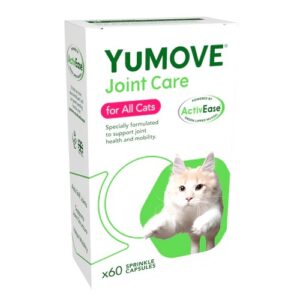Our furry friends, both cats and dogs, are enjoying extended lifespans. But as our beloved companions grow older, we might see signs of joint stiffness and decreased mobility creeping into their lives. Arthritis, a degenerative ailment that forces their bones to grind against each other painfully, is often the culprit behind this discomfort. Thankfully, a range of solutions is available, from over-the-counter pet supplements designed to alleviate joint stiffness to prescription medications specially crafted to relieve advanced stages of arthritis.
In our aging feline and canine companions, arthritis or osteoarthritis, can become a painful reality when the protective cartilage wears away, leading to bones rubbing against each other. This often causes significant discomfort and inflammation. If you start noticing changes in your pet’s behaviour, reduced activity levels and struggles with mobility, it’s a clear sign that a visit to the vet must be a priority to get to the root of the issue.
What causes arthritis in cats and dogs?

Arthritis can affect various areas in your pet’s body, including the back, elbows, shoulders, toe digits, ankles (tarsi), hips, and knees (stifles). It’s not just older cats and dogs who can be susceptible to arthritis; even younger ones may develop this condition, particularly after injuries like road traffic accidents or due to underdeveloped joints.
In a healthy joint, the bones are protected by smooth cartilage and lubricated with healthy joint fluid. This allows your pet’s bones to move without any pain or discomfort. However, when arthritis sets in, that smooth surface gradually wears away. As a result, the bones start rubbing against each other, causing pain, stiffness, and joint inflammation. These symptoms can lead to changes in your pet’s behaviour, reduced mobility, and a generally grumpy disposition. So, it’s crucial to stay vigilant and, if you have any concerns, don’t hesitate to discuss them with your veterinarian.
Is there a cure for arthritis in pets?
Regrettably, arthritis is a condition with no definitive cure; it tends to worsen as time goes on, necessitating careful monitoring by your veterinarian. Drawing on their expertise, your vet will evaluate your pet’s condition and recommend appropriate pain relief measures. This evaluation will also encompass assessing if your cat has any pre-existing medical conditions or potential drug interactions, particularly if they are currently taking other medications. Detailed clinical notes will be maintained to document these assessments and findings.
How long can a cat or dog live with arthritis?

With the proper, ongoing care, your furry companion can lead a high-quality life and enjoy many more years by your side. Thanks to medications that effectively reduce inflammation and alleviate pain, it’s important to set aside thoughts of euthanasia at this point. While it’s true that at some point, the quality of life might decline for various reasons, until that moment arrives, make the most of the pain relief options available and allow your cat or dog to savour every moment of their life. Initially, Molly was prescribed Loxicom which helped her walk from A to B like a normal cat.
Mobility limitation at home
As I mentioned earlier, providing your cat or dog with a good quality of life through pain management is possible. However, it’s important to acknowledge that their joints may not be as agile, and they might face challenges with activities they once relished. This is where small changes in your home environment become significant.
One crucial aspect is to “listen” to your pet – by this, I mean staying attuned to any changes in their behaviour. They may display signs of discomfort when picked up, just as my beloved Molly did. She adored cuddles, but I could tell that being lifted made her uneasy. She would often clutch at my clothing for additional support.
Your pet might also become grumpy or react adversely if you attempt to groom them in areas where arthritis is most severe. I was unsure whether Molly was trying to communicate that it was a problem area and wanted to avoid pain, or if despite the anti-inflammatories, being brushed made her feel uncomfortable. Regardless, being observant and understanding your pet’s cues is crucial for their well-being.
The signs of changes to look out for are:
- Your cat has difficulties jumping up onto higher levels
- Your dog has problems with steps
- A cat may find it hard to climb into a litter tray
- Your pet feels pain when you touch her
- Movement is slow
- Cutting claws is difficult because of a swollen digit
- Finding it difficult to lie down, get up, or bend forward to reach a food or drink bowl
- Walking a few paces and stopping because it is painful, then repeating attempts to walk
- Overall decrease inactivity
- Discomfort when picked up combined with nervousness
- The arched back could be arthritis in the spine
- Unable to balance as they once did – possibly because they feel insecure
These are the changes I made:
- A secondhand child’s stool for accessing an armchair or sofa
- An extra doorstep for garden access
- Water bowls on a stand with adjustable height
- Food bowls on raised surfaces – I used a floor scratch box from Asda and continued with Tabitha
- Microwave heating pad, hot water bottle wrapped in a towel, or a heated pad
- A litter tray with a low-sided base
- Change to a fine litter
- Bed stairs
- Help with grooming – this may include cleaning your cat’s bottom
- Car ramp for dogs
- General indoor ramp for small dogs and cats
The products highlighted are ones I have purchased.
Example of pain relief for cats and dogs

As mentioned, my veterinarian prescribed Loxicom and Onsior for my pet, so I have hands-on experience administering these two products. Your vet might recommend an alternative and the ultimate decision about the most suitable medication lies with your veterinary surgeon.
If your pet is prescribed Loxicom and Onsior, you won’t be able to buy these medications over the counter. You’ll need a prescription from your vet. More details in my article about buying a pet medication prescription can be found. If you take this route, your veterinary surgeon must assess your pet annually.
I was thrilled when I witnessed an improvement in Molly’s mobility within just an hour of her first Loxicom dose. Seeing her walk the entire room in one go brought immense joy to my heart. Both gave her mobility back and enabled her to live a better life.
- Loxicom to relieve inflammation – oral suspension
This product is designed to relieve inflammation and pain in cats and dogs. For dogs, it’s conveniently available in both liquid and tablet forms. Your vet will determine the appropriate dosage based on your pet’s body weight. The most encouraging aspect is that Loxicom gets to work within a matter of hours, and the satisfaction of watching your furry friend walk without pain is truly gratifying.
- Onsior to pain relief – tablet or injection
Onsior, as a nonsteroidal anti-inflammatory drug, is primarily used for postoperative pain relief. It’s unique in that it tends to linger more in the area of inflammation rather than spreading throughout the bloodstream. This characteristic allows for effective pain relief through daily administration. Based on what my veterinarian shared, Onsior is often considered a milder option compared to Loxicom.
- YuMove for Cats, dogs, horses and humans – a capsule form
YuMove Joint Care is a non-prescription joint supplement tailored for our furry friends who might feel stiff as they age. However, I strongly suggest that before you decide to buy it, you consult your vet and heed their recommendations. It’s crucial to remember that for more severe joint pain, YuMove may not provide the level of relief your pet needs.
The side effects of Onsior and Loxicom
I make it a rule to thoroughly go through the information provided with any medication, ensuring I’m aware of the potential side effects to be vigilant about. Additionally, I maintain a health diary for each of my pets. This practice proved invaluable when, after around three years, I observed dark blood in Molly’s feces. Thanks to my meticulous records, I was able to explain to the vet the frequency of these occurrences and he was able to pinpoint that the blood was originating from her intestines. As the issue escalated to almost daily appearances of dark blood, and then progressed to fresh blood, the vet decided to switch Molly to Onsior. Remarkably, the switch stopped the bloody discharge.
Loxicom side effects are:
- Vomiting
- Diarrhoea
- Blood in stools (dark or light)
- Renal failure
- Apathy
Onsior side effects are:
- Depression
- Anorexia
- Renal failure
- Vomiting
This is the point where I strongly emphasize the importance of keeping a close watch on your pet’s general well-being and staying informed about the potential side effects of any medication, whether administered by you or your veterinarian. Open communication with your vet is key. Maintaining a detailed diary is a great way to ensure that no critical details slip through the crack.
Disclaimer
This article does not give medical veterinary advice. Please consult your licensed veterinary surgeon for professional medical advice who will advise on health tests for your pet.
Poppys Pets is a participant in Awin and Amazon Associate affiliate programs which compensates me for referring traffic. It is of no extra cost to you and if thinking of buying a product, please consider using my link. It\'ll earn Poppy\'s Pets a few pennies to continue to this website. Only a selection of articles and videos on this website and YouTube channel contains affiliate links. Further information: Disclaimer and Privacy Policy


